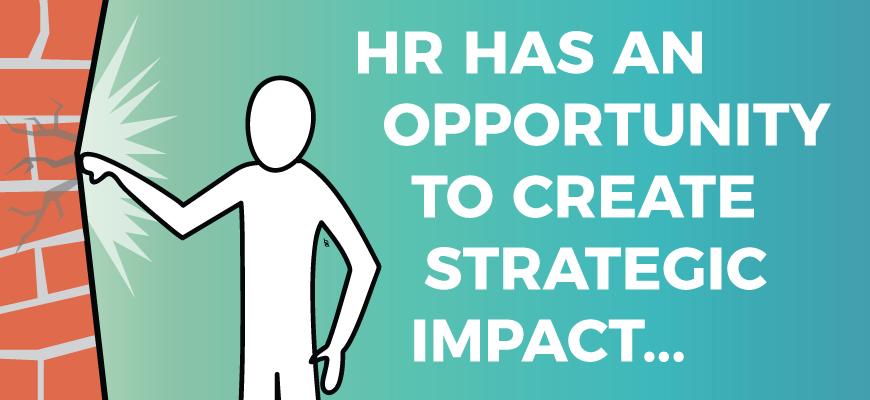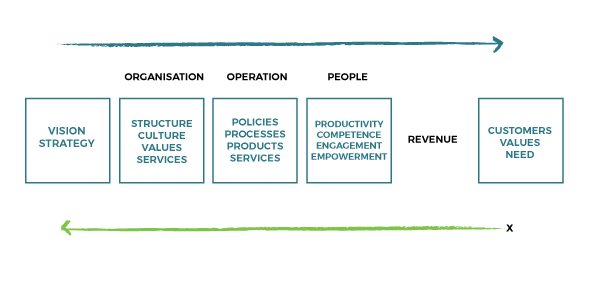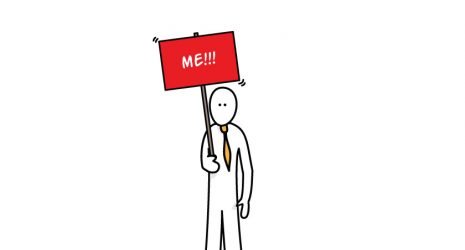Organisational Effectiveness – HR’s Opportunity for Strategic Impact

Organisational Effectiveness – HR’s Opportunity for Strategic Impact
How does HR make a business impact? By ensuring the organisation is aligned to execute the strategic decisions!
When HR takes primary responsibility for leading organisational effectiveness1 (Lawler, 2014) it creates a means of delivering the strategy and is a source of sizeable and durable competitive advantage2 (McKinsey 2012). HR should be eager and ready to take on assignments involving organisation design and effectiveness through strategic value-added activities such as a focus on talent (acquisition, development, retention, and motivation), learning, performance management and compensation planning2 (McKinsey 2012). Further enablers of sustainable organisation performance include leadership, engagement, knowledge sharing, culture, workforce planning etc3(CIPD 2010).
One prerequisite for success is that HR leadership tackles the ROI or business impact of HR head-on through data driven analysis and forecasting2 (McKinsey 2012). According to Richard et al4 (2009), organisational effectiveness captures organisational performance using internal operational efficiency performance outcomes and other external measures valued either by shareholders or customers such as corporate social responsibility.
SIX STEPS for the HR Function to Deliver Organisational Effectiveness
STEP ONE
Start with the customer by taking an ‘Outside-In’ perspective6, viewed from the customer’s need, it allows the company to create value for the customer and revenue for the firm. This perspective allows HR to determine which of its strategic enablers impact the ‘organisational value chain’ outcomes (see figure 1).
STEP TWO
Diagnose systematically7 (Mckinsey, 2014), using ‘diagnostic modelling’ to identify what is working and what is not. Once you have identified the area(s) that require attention you can put in place mitigation measures to improve the flow through the value chain. It could be a structural intervention or a workflow process intervention or a competence upgrade to front line staff or their supervisor.
STEP THREE
Realign strategic HR enablers to underpin delivery of the ‘organisational value chain’ (see figure 2). Introducing “outcome accountability”5 (Mitchell, 2012), allows HR to challenge and support the entire ‘organisational value chain’ so that the desired outcomes are achieved effectively according to the customer’s valued need. In practice, it means designing ways of working that specifically increase the effectiveness of each element in the chain in delivering value. A customer’s need may go unfulfilled due to a breakdown in the operational procedure or the skill of the person providing the service or because of the underlying culture that prevents the service provision from reaching the desired standard. Any, or all, of these causes can affect the outcome and HR can play a role in ensuring the whole value chain is ‘fit for purpose’.
Figure 1. A representation of the organisational value chain:

Figure 2. Strategic HR enablers aligned to the organisational value chain:
| Purpose | Organisation | Operation | People |
| Strategy Workshop Strategic Workforce Plan | Organisation Design Review Culture & Values Workshop Culture Survey Leader Training | Policy Alignment Process Audit Business Process Simulation Business Improvement Workshop Knowledge Management People & Service Alignment
| Capability Audit Talent Assessment, Acquisition & Retention Engagement Program Performance Management Delegated Authorities Compensation Planning Performance Coaching |
STEP FOUR
Design the organisation to ensure alignment of strategy with structure, processes and KPI measures to create a ‘congruent alignment’. Consider which structure is most appropriate for the strategy of the enterprise, for example Functional, Divisional or Matrix8 (George and Jones, 1996) and whether the managerial and organisational processes support the structure in the achievement of the strategy9 (David A. Garvin, 1998). Adding the right KPI measurement completes the alignment of the organisation with the strategic intent (see figure 3).
Figure 3. Congruent alignment from Strategy to KPIs:
| Strategy | Structure | Processes | KPI Measures |
| Customer Intimacy | Market (Divisional) | Customer Facing | • Customer Life Time Value • Customer Satisfaction |
| Product Excellence | Product (Divisional) | Production Quality | • Quality Feedback • Cost of Waste |
| Global Presence | Regional (Divisional) | Distribution Logistics | • Global Footprint • Market Density |
STEP FIVE
Measure the value of outcomes. The measurement of the changes introduced are derived from the initial diagnostics and must be tangible for the customer and for the organisation. The ROI and business impact should become an obvious ‘business case’. Target a productivity improvement goal (even if it seems hard to accredit success to the HR activity). Most productivity measures are economic10 (ONS) e.g. output per hour, output per job or output per worker and are based on gross output and or value added11 (OECD, 2001). Let’s take an example; A Sales Training Academy for a Global Life Insurance Organisation, reorganised its learning function to provide end-to-end support to sales and service agents by aligning talent, learning and performance reinforcement so that agents can capitalise on the knowledge of the organisation to make a better sales or service experience for customers. Measures included improved time to proficiency, agent productivity (number of policies sold), agent retention levels and net revenue gain (annual new premium written) whilst service measures included customer satisfaction and Net Promoter Score improvements. Using direct business metrics showed the effectiveness of the organisation in achieving its strategy.
STEP SIX
Organise HR work to deliver the organisational effectiveness value proposition. Review how HR is delivered – either within the HR function or, as Graber12 (2014) suggests, by embedding learning, development and talent acquisition within each business function to shift the focus from cost reduction to value creation. Consider the best model for your context. The aim is to create ‘Integrated HR’ that focuses on how competitive advantage is created through the value chain to impact business performance outcomes.
How well positioned is your HR function to take the opportunity for strategic impact through organisational effectiveness?
Author: Paul Tuck, Strategic Leadership
Paul hosts Strategic Positioning Events for the Strategic Leadership Group. Visit the events page to find one near you.
References
- HR Should Own Organisational Effectiveness, by Edward E. Lawler III, Forbes Publication, February 2014. https://www.forbes.com/forbes/welcome/?Tourl=https://www.forbes.com/sites/edwardlawler/2014/02/11/hr-should-own-organizational-effectiveness/
- False Summit: The state of Human Capital, Mckinsey & Company and The Conference Board Report 2012.
- Sustainable Organisation Performance, Shaping the Future, CIPD Interim Report 2010
- Richard et al. (2009): Measuring Organizational Performance: Towards Methodological Best Practice. Journal of Management.
- The Construct of Organizational Effectiveness; Perspectives From Leaders of International Nonprofits in the United States, Show all authors George E. Mitchell, Published February 13, 2012
- Victory Through Organization by Dave Ulrich, David Kryscynski, Michael Ulrich, Wayne Brockbank. Mcgraw Hill Education, 2017
- Building Capabilities for Performance, Richard Benson- Armer, Silke-Susann Otto, Gina Webster, Mckinsey & Company, 2014
- Understanding and Managing Organizational Behaviour; George and Jones; Addison Wesley Press 1996
- David A. Garvin; The Processes of Organization and Management; Magazine: Summer 1998Research Feature July 15, 1998
- Productivity Metric Definition, Office of National Statistics, 2017, https://www.ons.gov.uk/economy/economicoutputandproductivity/productivitymeasures
- Measuring Productivity, MEASUREMENT OF AGGREGATE AND INDUSTRY-LEVEL PRODUCTIVITY GROWTH, OECD Manual, 2001
- TALENT MANAGEMENT; It’s Not HR’s Job to Be Strategic, by Sean Graber, HBR, OCTOBER 31, 2014




